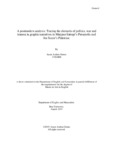| dc.contributor.advisor | Noman, Abu Sayeed | |
| dc.contributor.author | Gomes, Susan Andrea | |
| dc.date.accessioned | 2019-11-03T05:41:28Z | |
| dc.date.available | 2019-11-03T05:41:28Z | |
| dc.date.copyright | 2019 | |
| dc.date.issued | 2019-08 | |
| dc.identifier.other | ID 17263008 | |
| dc.identifier.uri | http://hdl.handle.net/10361/12823 | |
| dc.description | This thesis report is submitted in partial fulfilment of the requirements for the degree of Masters of Arts in Teaching to Speakers of Other Languages, 2019. | en_US |
| dc.description | Cataloged from PDF version of Thesis. | |
| dc.description | Includes bibliographical references (pages 56-57). | |
| dc.description.abstract | The paper aims to show how graphic novels can be included in the mainstream reading culture. Visual narratives not only glorify a culture or a country, but it also instruments to highlight the intricate and gruesome details of incidents such as violence and other forms of discrimination in a society. I intend to analyze two graphic novels namely Marjane Satrapi’s Persepolis I and II (2000, 2003) and Joe Sacco’s Palestine. The first half of the paper will be based on the history and importance of graphic novel. The paper also discusses the how graphic novels are gradually becoming a product of postmodern invention. The second half is a discussion on the analysis on the two graphic novels mentioned above.
The thesis is theoretically guided by Jean Francois Lyotard’s idea of metanarratives and language games to explain the usage of languages in visual narratives, Sigmund Freud’s ‘Traumatic Theory’ to decipher Sacco’s Palestine. Satrapi’s Persepolis being an autobiography of a female author, thus the paper also intends to look at the feminine persepective as well as the criticism attached to it. A set of theories based on graphic narratives will also guide the paper to its finality. | en_US |
| dc.description.statementofresponsibility | Susan Andrea Gomes | |
| dc.format.extent | 57 pages | |
| dc.language.iso | en | en_US |
| dc.publisher | Brac University | en_US |
| dc.rights | BRAC University theses are protected by copyright. They may be viewed from this source for any purpose, but reproduction or distribution in any format is prohibited without written permission. | |
| dc.subject | Graphic narratives | en_US |
| dc.subject | Palestine | en_US |
| dc.subject | Politics | en_US |
| dc.subject | War | en_US |
| dc.subject | Trauma | en_US |
| dc.subject.lcsh | Graphic novels | |
| dc.title | A postmodern analysis: tracing the elements of politics, war and trauma in graphic narratives in Marjane Satrapi’s Persepolis and Joe Sacco’s Palestine | en_US |
| dc.type | Thesis | en_US |
| dc.contributor.department | Brac Institutes of Languages | |
| dc.description.degree | M. in TESOL | |

